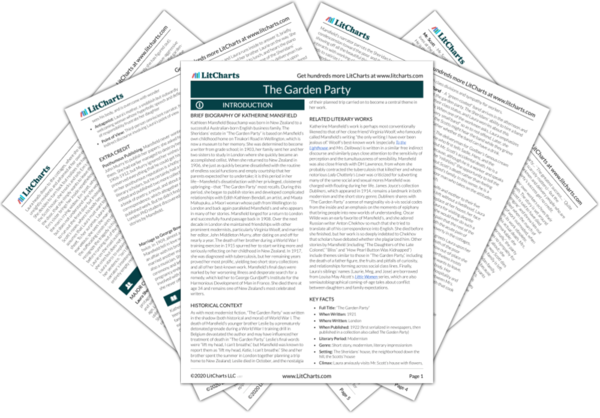Welcome to the LitCharts study guide on Katherine Mansfield's The Garden Party. Created by the original team behind SparkNotes, LitCharts are the world's best literature guides.
The Garden Party: Introduction
The Garden Party: Plot Summary
The Garden Party: Detailed Summary & Analysis
The Garden Party: Themes
The Garden Party: Quotes
The Garden Party: Characters
The Garden Party: Symbols
The Garden Party: Literary Devices
The Garden Party: Quiz
The Garden Party: Theme Wheel
Brief Biography of Katherine Mansfield

Historical Context of The Garden Party
Other Books Related to The Garden Party
Key Facts about The Garden Party
- Full Title: “The Garden Party”
- When Written: 1921
- Where Written: London
- When Published: 1922 (first serialized in newspapers, then published in a collection also called The Garden Party)
- Literary Period: Modernism
- Genre: Short story, modernism, literary impressionism
- Setting: The Sheridans’ house, the neighborhood down the hill, the Scotts’ house
- Climax: Laura anxiously visits Mr. Scott’s house with flowers, sees his body, and is overcome with wonder
- Antagonist: Laura’s mother, a snobbish but outwardly welcoming woman whose hyperbolic speech and deflection of responsibility frustrate her daughter
- Point of View: Third-person omniscient narrator, free indirect discourse involving Laura’s point of view
Extra Credit for The Garden Party
Posthumous Publishing. Mansfield never wanted her husband John Murry to publish her papers; she asked him to dispose of them. She had earlier managed to destroy her journals from 1906-1912, but Murry ignored her wishes and meticulously preserved everything that he could get his hands on. His effect on her posthumous reputation is a hotly-debated topic among literary scholars, but he certainly had a significant one: he edited and published two more collections of her short stories, a book of poetry, a novel, and about a half-dozen books of correspondence, which altogether comprise the majority of her published work. But he didn’t find everything: in 2012, a London PhD student discovered four previously unknown stories by Mansfield.
Marriage to George Bowden. Mansfield actually married twice. In 1909, almost a decade before she married Murry, Mansfield fell in love with a musician who spurned her. She had an affair with his brother, got pregnant, and then suddenly married another man altogether: George Bowden, who was also a musician. She purportedly wore a funeral dress to the ceremony and left Bowden forever after only a few hours. The pregnancy ended in miscarriage, and Mansfield was also involved with her closest friend and fellow writer Ida Baker, but she never officially divorced Bowden for eight years.







